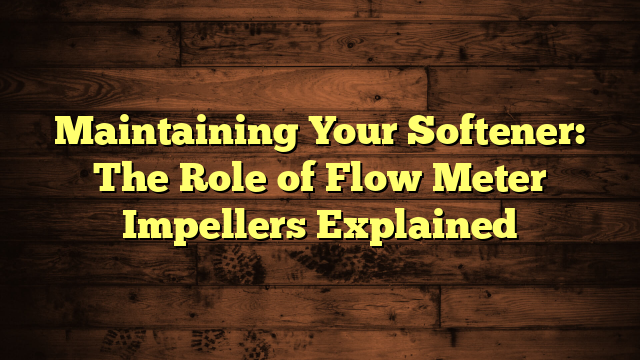Why Water Softner Keep Showing Salt Warning?
If your water softener keeps showing a salt warning, you might wonder what's going on. It could be as simple as low salt levels in the brine tank, or perhaps there's a salt bridge forming, blocking the salt from dissolving properly. Malfunctioning sensors could also be at play, giving you false readings. Regular maintenance is key, but what if you've done everything right and the warning persists? Understanding the underlying issues can help you tackle this problem effectively and restore your system's performance.
Key Takeaways
- Low salt levels in the brine tank can trigger salt warnings; ensure the tank is at least half full regularly.
- Sensor malfunctions, such as faulty calibration or debris buildup, can cause false salt warnings.
- High hardness levels in water may lead to overworking the system, resulting in alerts.
- Salt bridges can form due to hardened salt in the tank, preventing effective regeneration.
- Issues with resin beads, like clogging or degradation, can hinder softening and cause frequent salt warnings.
Understanding Water Softeners
What do you really know about water softeners? These systems play a crucial role in improving your water quality by removing minerals like calcium and magnesium that cause hardness. To understand how they work, you should start with water testing. Testing your water reveals the hardness level and helps you determine the right softener type for your needs.
There are several softener types available, including salt-based and salt-free options. Salt-based softeners use sodium ions to replace the hard minerals in your water, while salt-free models use alternative methods like template-assisted crystallization. Knowing which type suits your home is essential for optimal performance.
When you install a water softener, you'll notice immediate benefits, such as softer skin after showering and cleaner dishes. However, it's important to monitor your system regularly. This includes checking the salt levels and the efficiency of your softener type.
Regular maintenance ensures your water remains soft, enhancing your comfort and extending the lifespan of your appliances. By understanding water softeners and conducting regular water testing, you can enjoy the perks of softened water while avoiding potential issues down the line.
Common Causes of Salt Warnings
Salt warnings can arise from several common issues that affect the performance of your water softener. One key factor is the type of salt you're using. Not all salt types are created equal; some may contain impurities or have low solubility, which can hinder your softener's efficiency.
If you're using rock salt, for example, it might leave residue that clogs the brine tank and affects the regeneration process.
Another reason for salt warnings could be a malfunctioning float switch. If the switch isn't operating correctly, it may not accurately gauge the salt level, leading to false warnings.
Additionally, if your system is overworking due to high hardness levels in your water, it could struggle to keep up with the demand, triggering a salt warning.
Lastly, check for any software or firmware issues with your softener. Outdated systems may misinterpret readings, resulting in unnecessary alerts.
Low Salt Levels
Maintaining low salt levels in your water softener can lead to performance issues that affect water quality. When you don't manage salt levels properly, you might notice warning signs such as decreased effectiveness in softening water or an increase in hard water stains on your fixtures. This can be frustrating, especially if you rely on your water softener for clean, soft water.
To avoid these problems, you should regularly check the salt level in your brine tank. Aim to keep it at least half full to ensure optimal performance. If you notice that the salt level is low, it's important to add salt promptly. Ignoring low salt levels can result in inefficient regeneration cycles, leaving you with hard water and potentially damaging your plumbing.
Effective salt management not only prolongs the life of your water softener but also ensures you get the best quality water.
Remember to stay vigilant about monitoring salt levels, and don't hesitate to respond to any warning signs. By doing so, you'll help maintain your water softener's efficiency and keep your home's water supply in top shape.
Salt Bridge Formation
A common issue you might encounter with your water softener is salt bridge formation. This occurs when the salt in the brine tank hardens, creating a crusty layer that prevents the water from dissolving it effectively. When this happens, your softener can't regenerate properly, leading to inadequate water softening and triggering that pesky salt warning.
To prevent a salt bridge from forming, you can implement several prevention methods. First, regularly check the salt levels in your brine tank and ensure they're sufficient. When the salt gets low, it's more prone to hardening.
It's also essential to use high-quality salt, as impurities can contribute to bridging. Make it a habit to occasionally stir the salt in the tank, which helps break up any crust that might be forming.
Additionally, consider the humidity levels in your area; high humidity can lead to moisture buildup, increasing the chances of a salt bridge. If you do find a salt bridge, you can break it up with a broom handle or similar tool.
Regular maintenance and these simple tricks will keep your water softener running smoothly.
Malfunctioning Sensors
If your water softener isn't working properly, malfunctioning sensors could be the culprit.
You might be dealing with faulty sensor calibration, debris buildup, or even electrical connection issues.
It's crucial to identify these problems to ensure your system runs smoothly.
Faulty Sensor Calibration
When it comes to water softeners, faulty sensor calibration can lead to significant issues in your system's performance. If your sensor isn't accurately measuring the salt levels, it might trigger false warnings, leaving you puzzled. You might think you need to add more salt when, in fact, you don't. This miscalibration directly affects sensor accuracy, resulting in poor water softening and potential equipment damage.
To keep your water softener running efficiently, it's crucial to understand the calibration methods used. Regularly checking and recalibrating your sensors can help maintain their accuracy. Different systems may use various calibration methods, so refer to your owner's manual for specific guidelines.
If you notice persistent salt warnings, take the time to assess your sensor calibration. You can often perform a simple recalibration yourself, or if the problem persists, it might be time to call a professional.
Debris and Buildup
Sometimes, debris and buildup in your water softener can lead to malfunctioning sensors, causing inaccurate readings and frustrating alerts. If you notice a persistent salt warning, it mightn't be a salt issue at all. Instead, the sensors could be obstructed by dirt, salt bridges, or other contaminants that interfere with their proper function.
To tackle this problem, start with regular debris removal. Make it a habit to check the brine tank and resin bed for any signs of buildup. If you spot any debris, clean it out promptly. Use a soft brush or cloth to avoid damaging the components.
Also, ensure the brine tank is free from any salt clumps or bridges that can form if the salt level gets too low.
Buildup prevention is equally important. Maintain your water softener by following a regular cleaning schedule. Performing routine maintenance can go a long way in keeping your sensors functioning correctly.
Electrical Connection Issues
Malfunctioning sensors in your water softener can often stem from electrical connection issues. If your system's sensors aren't working properly, it may trigger a persistent salt warning. You might want to start by checking the electrical connections. Loose or corroded connections can disrupt the signal between the control panel and the sensors, leading to false alerts.
Next, inspect the wiring for any signs of wear or damage. Frayed wires or poor insulation can cause intermittent signals, making it seem like your softener is low on salt when it's not. Sometimes, a simple reconnection or tightening of screws can resolve the issue.
If you're comfortable doing so, make sure to turn off the power before you investigate the wiring. Also, consider consulting the user manual for specific guidance on your model.
If these steps don't solve the problem, it might be time to call in a professional. They can diagnose more complex electrical issues that may be affecting your system's performance. Taking care of these electrical connection issues promptly can save you from unnecessary salt purchases and ensure your water softener functions efficiently.
System Maintenance Issues
When maintaining your water softener, watch out for common issues like a clogged salt tank, low salt levels, and resin bead problems.
Neglecting these can lead to decreased efficiency and costly repairs.
Regular checks will help ensure your system runs smoothly and effectively.
Clogged Salt Tank
A clogged salt tank can lead to significant issues in your water softener system. When you neglect salt tank maintenance, it can affect performance and efficiency.
Here's what you might notice if your salt tank is clogged:
- Reduced Water Softening: Hard minerals may not be effectively removed, leading to scale buildup in pipes and appliances.
- Salt Bridges: These hard crusts can form on top of the salt, preventing it from dissolving properly.
- Increased Salt Usage: You might find yourself adding more salt than necessary due to inefficient dissolving.
- Frequent Salt Warnings: The system may trigger salt warnings even when there's salt present, causing confusion.
To avoid these issues, regular salt tank cleaning is essential.
Check for clogs, and make sure the salt can flow freely. If you notice any signs of a blockage, take action immediately.
By keeping up with your salt tank maintenance, you ensure your water softener runs smoothly and effectively.
Neglecting this crucial step can lead to bigger problems down the line, so don't skip it!
Low Salt Level
Maintaining the correct salt level in your water softener is crucial, as even a modest dip can lead to system inefficiencies. If your system keeps showing a salt warning, it might be time to reassess your salt replenishment techniques. Regular monitoring of the salt levels can prevent this issue, ensuring your water softener operates effectively.
Here's a quick guide to help you choose the best salt types and the techniques for replenishing salt levels:
| Best Salt Types | Salt Replenishment Techniques | Frequency of Check |
|---|---|---|
| Rock Salt | Manual refill | Monthly |
| Solar Salt | Automatic refill systems | Bi-monthly |
| Evaporated Salt | Visual inspection | Weekly |
Choosing the right salt type, like evaporated salt, can enhance efficiency. Implementing proper salt replenishment techniques will keep your system running smoothly, eliminating the salt warning alerts. Make it a habit to check levels regularly; your water softener will thank you for it.
Resin Bead Issues
Salt levels aren't the only factor that can affect your water softener's performance; resin bead issues can also lead to significant system inefficiencies.
When resin beads become dirty or worn out, they can't effectively remove hardness from your water. Here are some common resin bead issues you might encounter:
- Clogging: Mineral buildup can obstruct resin flow, diminishing softening efficiency.
- Degradation: Over time, resin beads can break down, losing their ability to soften water.
- Channeling: Uneven distribution of water can lead to certain areas of the resin bed being overworked, while others remain underused.
- Contamination: Foreign substances can interfere with the resin's function, requiring more frequent resin maintenance.
To maintain optimal performance, regularly check your resin beads for these issues.
If you notice problems, it might be time for resin replacement. Keeping your resin in top shape ensures your water softener works effectively, preventing unnecessary salt warnings.
Regularly scheduled maintenance can save you from future headaches and keep your water softener running smoothly.
Troubleshooting Tips
When your water softener isn't performing as expected, troubleshooting can help identify the issue quickly. Start by checking the salt levels in the brine tank. If you're using the wrong salt types—like rock salt instead of solar salt—it can lead to clogs and reduced efficiency. Make sure you're using a high-quality salt designed for water softeners.
Next, inspect the brine line for any blockages or kinks that might prevent salt from dissolving properly. If you notice any issues, clear them out. You might also want to clean the brine tank periodically to remove any accumulated sludge.
Another essential step involves reviewing the settings on your water softener. Ensure that the regeneration cycle is programmed correctly. If the settings are off, it mightn't be regenerating as needed, leading to a salt warning.
Lastly, consult the user manual for troubleshooting techniques specific to your model. If these steps don't resolve the problem, consider contacting a professional for further assistance.
Keeping your water softener well-maintained will ensure it runs smoothly and efficiently for years to come.
Frequently Asked Questions
How Often Should I Check My Water Softener's Salt Levels?
You should regularly check your water softener's salt levels to ensure optimal performance. Aim for weekly checks during heavy use and monthly during lighter use. Consistent salt level maintenance prevents issues and keeps your system running smoothly.
Can I Use Any Type of Salt for My Water Softener?
You can't just use any type of salt for your water softener; it's best to stick with solar or evaporated salt. Some salt alternatives might work, but always check your manufacturer's recommendations first.
What Is the Best Way to Store Water Softener Salt?
To store water softener salt effectively, keep it in a cool, dry place. Ensure you're using airtight containers to maintain optimal conditions, preventing moisture absorption that can affect salt quality and performance.
Will Hard Water Damage My Appliances if I Ignore Salt Warnings?
Ignoring salt warnings can cause hard water effects, leading to mineral buildup in your appliances. This buildup reduces appliance longevity, making them work harder and ultimately shortening their lifespan. Regular maintenance ensures optimal performance and durability.
How Do I Reset the Salt Warning on My Water Softener?
To reset the salt warning, check your water softener's manual for specific steps. Generally, you'll press the reset button or adjust settings. For troubleshooting tips, ensure salt levels are adequate and clean the brine tank regularly.
Conclusion
In conclusion, if your water softener keeps showing salt warnings, don't panic. Check the salt levels, look for any salt bridges, and inspect the sensors for proper functioning. Regular maintenance is key to preventing these annoyances. By staying proactive and addressing issues promptly, you can ensure your system runs smoothly and efficiently. Remember, a little attention can prevent bigger problems down the road, so keep an eye on your water softener for optimal performance.







